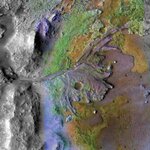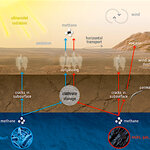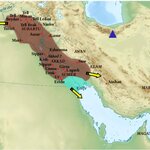Geology

In 1799, Alexander von Humboldt set sail on a 5-year, 8000-km voyage through Latin America. His journey through the Andes Mountains, captured by his famous vegetation zonation figure featuring Mount Chimborazo, canonized the place of mountains in understanding Earth's biodiversity.
One puzzle for scientists since von Humboldt 250 years ago, and certainly later with Darwin, Wallace, and Mendel, was global pattern of mountain biodiversity, and the extraordinarily high richness in tropical mountains in particular.
Two new papers focus on the fact that the high level of biodiversity found…

Human land use due to manufacturing, population, and agriculture changing the shape of earth itself has been termed the Anthropocene Epoch, but if less hyperbolic scientists of the future agree with that at all, they are likely to agree it started 4,000 years before cars were invented.
Significant global landcover change had occurred by then, so if a new epoch really did start, it was not in the 20th century, finds a new study by a large international team of archaeologists and environmental scientists behind the ArchaeoGLOBE project.
The scholars pooled extensive datasets summarizing…

Mars may seem hospitable only for cute robots now, but 3 to 4 billion years ago it was warm enough to have rainstorms and flowing water, followed by a longer cold period where the water froze - a lot like earth.
Scientists have long known that water was abundant on ancient Mars, but there has been no consensus on whether liquid water was common, or whether it was largely frozen in ice. Was the temperature high enough to allow the water to flow? Did this happen over an extended period, or just occasionally? Was the surface a desert or frozen? Warm conditions make it much more likely that…

Paper clams or 'flat clams' were widespread in the Triassic. We call these bivalves 'flat clams' because of their very thin shell width and narrow valve convexity. They often dominate the rocks in which they are found, as in these specimens from Pine Pass near Chetwynd in the Foothills of northeastern British Columbia.
Pine Pass is part of the Pardonet Formation. Just a short hike from the road we were able to easily find the abundant outcroppings of the paper clam, Monotis subcircularis, perfectly preserved and cemented in this strata from the Late Triassic. Because of their widespread…

“When the tide is out, the table is set.” This wisdom from those who call Haida Gwaii home is still true today. The enormous difference between high and low tide in Haida Gwaii – up to twenty three vertical feet – means that twice a day, vast swathes of shellfish are unveiled, free for the taking.For many cultures, obtaining the stable food supply and permanent residences needed to develop advanced artisanship and specialized trades and crafts required becoming an agrarian society: clearing fields, planting crops, and/or raising livestock. But for the Haida, Mother Nature served as farmer,…

There are lots of paradoxes in nature but one - how earthquakes along mid-ocean ridges are linked with low tides - may have revealed a mechanism.
The mechanism is the magma below the mid-ocean ridges.
"It's the magma chamber breathing, expanding and contracting due to the tides, that's making the faults move," says Christopher Scholz, a seismologist at Columbia University's Lamont-Doherty Earth Observatory.
Low tide correlation to earthquakes is surprising because of the way the mid-ocean fault moves. The fault as a tilted plane that separates two blocks of earth. During movement, the upper…

In the Chinese science fiction film The Wandering Earth, recently released on Netflix, humanity attempts to change the Earth’s orbit using enormous thrusters in order to escape the expanding sun – and prevent a collision with Jupiter.
The scenario may one day come true. In five billion years, the sun will run out of fuel and expand, most likely engulfing the Earth. A more immediate threat is a global warming apocalypse. Moving the Earth to a wider orbit could be a solution – and it is possible in theory.
But how could we go about it and what are the engineering challenges? For the sake of…

Methane detection in the Martian atmosphere haa been a source of debate because methane means a greater possibility for habitability and may even be a signature of life., but spacecraft and telescopic observations from Earth reported no detections of methane, at least not outside the realm of statistical wobble.
Finally, independent measurements report a firm detection in the Martian atmosphere above Gale Crater on 16 June 2013 by the Planetary Fourier Spectrometer onboard Mars Express, one day after the in situ observation of a methane spike by the Curiosity rover.
Methane was not detected…

Gol-e-Zard Cave lies in the shadow of Mount Damavand, which at more than 5,000 metres dominates the landscape of northern Iran. In this cave, stalagmites and stalactites are growing slowly over millennia and preserve in them clues about past climate events. Changes in stalagmite chemistry from this cave have now linked the collapse of the Akkadian Empire to climate changes more than 4,000 years ago.
Akkadia was the world’s first empire. It was established in Mesopotamia around 4,300 years ago after its ruler, Sargon of Akkad, united a series of independent city states. Akkadian influence…

There are many sensationalist stories today about this research. But they were looking at the past history of this volcano. Not the present. It is not ready to collapse right now and is closely monitored. Likely to be centuries to millennia before a collapse if one is possible at all - it may have ended that phase too. A normal eruption would be devastating for local people and it is closely monitored. It probably did not make the Neanderthals extinct but the 2–4C global temperature reduction for a couple of years might have helped modern humans to get an edge over the Neanderthals at a…